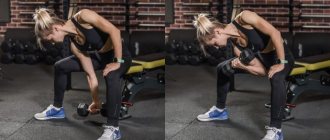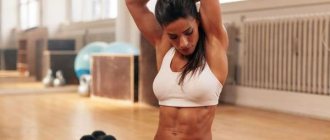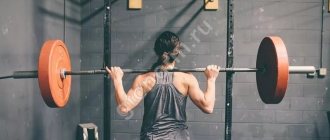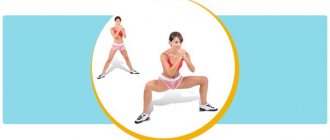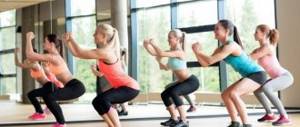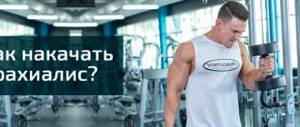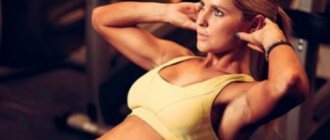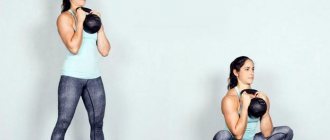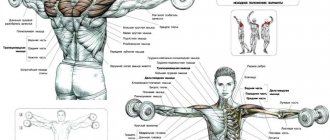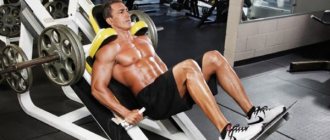Deep squat self-test
Starting position: feet shoulder-width apart, slightly turn your hips outward.
Test: Squat down so that your thighs are parallel to the floor, keeping your back straight. Stop and then return to the starting position.
Criteria for verification:
- the squat should be performed smoothly, without jerking;
- keep your back straight throughout the entire exercise;
- the knees are directly above the feet;
- don't lose your balance;
- the feet are completely pressed to the floor throughout the entire exercise;
- maintain a neutral head position.
To evaluate your performance according to all criteria, squat in front of the mirror: first facing it, and then sideways.
You can also ask a friend to follow your movements. It can be difficult to assess the position of the body ourselves, and in addition, we often lack self-criticism.
A good option is to ask to be filmed. You will be able to watch the video several times, evaluate your technique and notice any mistakes.
So, if you managed to perform the test perfectly, following all the criteria for correct technique, congratulations! You can perform squats with free weights without fear of injury.
If your technique does not correspond to the correct one according to any of the criteria, it means that weak or, conversely, tight muscles do not allow you to perform the exercise correctly. In this case, before picking up dumbbells or a barbell, you need to correct your mistakes.
Basic mistakes when performing squats
The life hacker will look at four common mistakes in squatting technique and help correct them.
Mistake #1: Knees roll inward.
This is a common mistake that is especially common when working with free weights. The reason for this error lies in weak hip abductor and hip rotator muscles.
How to fix
To strengthen these muscles and restore proper movement patterns, perform exercises with resistance bands. If there is no such tape, a loop expander folded in half will also do. In the photo below I am performing the exercise with exactly this.
1. Squats with an expander
Squat slowly, making sure that your knees are turned outward, and just as slowly return to your starting position. Stay in the lower position for a few seconds, try to feel which muscles resist the pressure of the elastic band.
The good thing about this exercise is that you almost don't have to consciously turn your knees outward, it happens naturally: when you squat, the band pulls your knees inward, and the body automatically reacts to this by turning your hips outward.
If you feel comfortable with the resistance band, gradually increase the pressure until you can perform the exercise correctly without the band.
2. Squat leg raises
In addition to regular squats with a band, you can also perform knee extensions and knee extensions at the bottom. Perform a squat, release a little control by allowing the band to curl your knees inward, and then open your legs until your knees are in the correct position. Repeat several times and then return to the starting position.
3. Steps to the side with an expander
Place a resistance band on your legs, under your knees or around your ankles, and perform side steps.
Basically, the tension will be felt not in the walking leg, but in the supporting leg. Make sure that your knees do not turn inward during steps, otherwise the exercise loses its meaning.
Mistake #2: Not squatting deep enough.
If you cannot squat lower so that your thighs are parallel to the floor, then you lack mobility in the hip joint. In other words, tight muscles limit your range of motion.
Your task is to relax and stretch the muscles that prevent you from squatting deeply enough: the hamstrings and gluteal muscles.
The video below contains stretching exercises for these muscles, which are performed on the floor, on an elevated platform, and with the help of a rubber expander band.
Mistake #3: Heels lift off the floor.
If you cannot squat with your feet flat on the floor, then you have tight calf muscles.
To stretch your calf muscles, use the following exercises:
Mistake No. 4. The back is rounded
Perhaps it's again the tight muscles in the hamstrings and buttocks. When squatting, they limit the range of motion, preventing you from bending forward.
To stretch these muscles, use the exercises shown in the video above. You can also do wall squats, which gradually trains your body to squat with a straight back.
Stand facing the wall, your feet are located at a distance of 15–45 centimeters from it, your hands are on the wall. During the squat, focus on the position of your back: it should remain straight throughout the entire exercise.
Features of treatment
If a person does not suspect any infectious nature of the disease, then treating it is quite simple. First of all, it is necessary to significantly limit the load on the joint. This will make it possible to restore normal blood microcirculation in the joint. Physiotherapeutic procedures will be useful:
- hydromassage;
- warm baths;
- compresses made from heated mountain wax.
As you can see, pain in the knee joint after squatting is not uncommon. However, symptoms noticed in time can prevent the occurrence of complications. Be healthy!
Good afternoon! As a child (kindergarten and earlier), I could never squat without lifting my heels, unlike most children. Then, from the age of 5, I took dancing lessons - even then my artistic director said that I would not be able to pull my toes correctly (my foot had never fully stretched). He even announced this to the other girls, saying: at least she will be able to walk in heels without feeling tired. Then I didn’t understand, and I didn’t understand the essence, I was little. Then school, ski section, standard: squats on one leg, the other extended parallel to the floor - parallel was never achieved. Next is fitness (aerobic exercise, step + a little strength training) for the soul, 3-4 times a week + swimming. So I lived until I was 27 years old. Now I'm into Hot Iron. I fell madly in love with strength training. And now my whole childhood is before my eyes: I can’t squat with a barbell. I want to cry. Even “buns” who came to classes for the first time in their lives are able to perform a squat correctly at least once. But not me. I've been training since I was 5 years old. What is the reason? Do problems really start from childhood? Physiology? I'm not lazy, on the contrary. Whatever I take up, I won’t leave until I perfect it to perfection. Perhaps the only thing that doesn’t work out in life is the squat. Could this be due to physiology, or does the Achilles tendon need to be stretched, or something else? Please, help. Classes in the gym are my happiness, my joy, I can’t live without them. I'm terribly upset about this.
Elena, Perm, Russia, 27 years old
What you need to know about squats
At first glance, as already said, it seems that this is a simple and natural process of human movement. In part, this is true, the squat reflex has been in us since infancy, but after some time, the body forgets the correct movements of the joints. Squatting is the best action for strengthening the lower body, and is a base load for a reason.
A huge number of groups are involved, namely, the hamstrings, buttocks, core stabilizer and others.
To perform this physical activity correctly, you do not have to be an athlete or an experienced fitness trainer; it is important to know the basic technique and follow some rules.
Basic recommendations to follow during training
In the first training of this exercise, you need to know the following features: • Watch your back and its deflection, you need to be straight all the time. Posture also relieves tension from the spine, thereby reducing the possibility of injury. • Heels. It is extremely rare to be lifted off the floor. When performing a squat, the weight should remain on the heels and not on the toes, that is, transferring body weight to the front is prohibited. Even when you go down to the lowest point, your heels are pressed firmly to the floor. • The knees cannot be brought inward or further apart than the line of the feet. Watch their position; if you deviate from the rule, the weight of the burden will fall on your knees, and the load will go to the joint. • The neck and head are straight, as is the back. Many people, while doing a workout, lower their head and look like a question mark, thereby putting unnecessary stress on the cervical spine. • The position of the legs should remain slightly bent at the knees when raised up. This way the load on many muscles is separated, and the physical load goes back to the knee joint. • At first, it is advised not to go too low, to the level of the hip to the floor, later, if you feel well, you can do a deeper squat.
Mistake 2: Do your toes lift?
When our toes lift off the surface, we face the opposite problem. If your toes don't press into the ground, you're putting all the weight of the barbell into your heels. This overloads the posterior muscle chain.
That's right: you can overtrain your posterior chain if you overwork it day after day—especially if you do the following exercises frequently:
- Classic squat (load on the heels prevails).
- Romanian deadlift (predominant load on the heels).
- Reverse hyperextension.
- Glute bridge with barbell.
- Exercise Superman.
To correct a forefoot slip, use the tripod maneuver described above and perform towel curls to strengthen the foot muscles.
Squat technique
As mentioned earlier, squats are the gold exercise, the foundation of all workouts. It develops in addition to the legs, buttocks, and also a very effective way of building muscle mass. Doing physical activity in the form of squats engages several muscle groups at once: joint - ankle, knee, hip. In all exercises, without knowing the literacy of physical activity, unfortunately, there is a possibility of harming your health, instead of the desired benefit. Especially if you haven’t been particularly close to sports before and your muscles are not prepared. In addition to the basic recommendations mentioned above, let's add the following technique: • Keep your abdominal area toned and tense. This will serve as a protective corset around the waist, fixing the spinal column. • Once again about posture - do not arch, the line from the tailbone to the head must be straight. • Take a full breath of air, continuously.
Variation of squat training
Having familiarized ourselves with the basic rules and theory, we move on to practice. You should start doing them only after warming up and stretching. Throughout the exercise, keep your shoulder blades squeezed together to help keep your back straight. No sudden movements; if desired, after some time of practice, add weights - barbells, dumbbells. Perform fifteen squats, each of the listed ones. • Classic simple squat. Standing position straight, feet shoulder-width apart, back straight. Inhale, move your pelvis slightly back, bend your knees, exhale, straightening your legs, return to the starting position. The benefits of this type are that all leg muscles are fully involved. After constant practice, you can add a squat with dumbbells in both hands. • Strengthening the external and internal ligaments of the hips, an exercise called “Plie” is performed. The action most often begins in a standard way - feet shoulder-width apart, back straight. But in this squat, your toes should point diagonally, slightly wider than your shoulders, and place your hands on your belt. Inhale, lower yourself down, straightening your knees, and exhale as you rise up again. • It’s not very easy, but it has a great effect on the gluteal muscles, an exercise with narrow foot placement. You guessed it, keep your feet together, everything else is done following the example of a classic squat. • Also contributes to the development of the buttocks - curtsy. Cross your legs, exhale, bend your legs to a right angle, the body weight is transferred forward, the second foot is on the toe, do not fall on your heels. Somewhat reminiscent of lunges, exhale, rise. • If you feel strong and ready to increase the load, perform the Balance squat. Feet are hip-width apart, and the heel of one leg is lifted off the floor. While squatting, keep your weight on the leg that is on your heel, change legs and repeat in the same way. • To the basic workouts, you can add advanced exercises, such as a buckle from a squat position, squats with side lunges, a squat exercise on one leg, using the back of a chair and many others, taken as a base, a classic exercise.
What are the benefits of squatting?
The shape of the so-called fifth point is influenced by the pelvic bone, muscle corset, and the volume of adipose tissue. It is impossible to do anything with the bone, but the second two factors can be changed, and muscle changes play an important role. With the help of training with squats, you can not only reduce the volume of fatty tissue, but also pump up, that is, increase and round the volume of the buttocks. During squats, not only muscles work, but also joints and tendons, which improves their condition. And of course, this is a cardio load, which gives a favorable result for the functioning of the cardiovascular system, a healthy heart rhythm is formed. Based on this, you will not only form beautiful shapes of your buttocks and legs, but also improve your health yourself, avoiding the cost of a fitness club.
Write your comment Cancel reply
You must be logged in to post a comment.
Squatting incorrectly, especially with free weights, is very harmful to the spine and knees. Lifehacker provides tests for self-checking squatting technique, common mistakes and ways to correct them.
You won't be able to perform the exercise correctly until your body is ready for it. For example, if you have limitations in the mobility of the hip joint, then you simply physically will not be able to perform a squat correctly. And even more so, you should not try to squat with weights: this can have a bad effect on the health of your knee joints and spine.
So before you do weighted squats, check to see if you can do them correctly.
Fitness trainer's answer:
Hello, Elena.
Unfortunately, without seeing how you perform the exercise and what exactly is the mistake, I cannot draw any conclusions. But if difficulties arose constantly, it is quite possible that some peculiarities of the physiological structure are present. Based on my work experience, I can say that sometimes even gait features can be the cause of this kind of problem. But competent specialists in the field of medicine must identify these reasons.
Sincerely, Victoria Monchenko.
»
Kozhushko NikitaPresentation contains information about the mechanisms of sleep and dreams Download: Preview: To use the preview of presentations, create a Google account and log in:…
- Sleep and dreams This is inhibition of the main sections of the cerebral cortex, due to which neurons rest and their functionality is restored. The biological rhythm of sleep is associated with the change of day and night. Meaning of sleep I have a dream that...
- What can you see with your eyes closed? (slide14) Correct. The topic of the lesson is “Healthy sleep”. (slide 15) Sh. Updating knowledge, planning. Today in class we will learn (slide 16) 1. What is sleep? 2. Why do we wheeze at night? 3. What types of…
- Description of the presentation on individual slides: 1 slide Description of the slide: 2 slide Description of the slide: Sleep is the inhibition of the main parts of the cerebral cortex, due to which neurons rest and are restored...
Deep squat self-test
Starting position: feet shoulder-width apart, slightly turn your hips outward.
Test: Squat down so that your thighs are parallel to the floor, keeping your back straight. Stop and then return to the starting position.
Correct squat
Criteria for verification:
- the squat should be performed smoothly, without jerking;
- keep your back straight throughout the entire exercise;
- the knees are directly above the feet;
- don't lose your balance;
- the feet are completely pressed to the floor throughout the entire exercise;
- maintain a neutral head position.
To evaluate your performance according to all criteria, squat in front of the mirror: first facing it, and then sideways.
You can also ask a friend to follow your movements. It can be difficult to assess the position of the body ourselves, and in addition, we often lack self-criticism.
A good option is to ask to be filmed. You will be able to watch the video several times, evaluate your technique and notice any mistakes.
Mistake 4: Do you lift your arches?
The three errors we discussed are the result of a lack of attention while performing the movement. Rolling your arches, on the other hand, is a conscious overcorrection and is a learned skill. During squats, weightlifters are often told by trainers to “push their knees out” to prevent them from collapsing inward. The trainer has good intentions, but the result can be a movement pattern that interferes with proper knee joint alignment.
The good news is that like other mistakes, this one can be corrected by using the tripod technique. By eliminating any of the problems discussed with the tripod technique, you will create a solid foundation for the entire body from which you can lift weights much more effectively and without unnecessary risk.
Basic mistakes when performing squats
The life hacker will look at four common mistakes in squatting technique and help correct them.
Mistake #1: Knees roll inward.
This is a common mistake that is especially common when working with free weights. The reason for this error lies in weak hip abductor and hip rotator muscles.
How to fix
To strengthen these muscles and restore proper movement patterns, perform exercises with resistance bands. If there is no such tape, a loop expander folded in half will also do. In the photo below I am performing the exercise with exactly this.
1. Squats with an expander
Squat slowly, making sure that your knees are turned outward, and just as slowly return to your starting position. Stay in the lower position for a few seconds, try to feel which muscles resist the pressure of the elastic band.
The good thing about this exercise is that you almost don't have to consciously turn your knees outward, it happens naturally: when you squat, the band pulls your knees inward, and the body automatically reacts to this by turning your hips outward.
If you feel comfortable with the resistance band, gradually increase the pressure until you can perform the exercise correctly without the band.
2. Squat leg raises
In addition to regular squats with a band, you can also perform knee extensions and knee extensions at the bottom. Perform a squat, release a little control by allowing the band to curl your knees inward, and then open your legs until your knees are in the correct position. Repeat several times and then return to the starting position.
3. Steps to the side with an expander
Place a resistance band on your legs, under your knees or around your ankles, and perform side steps.
Basically, the tension will be felt not in the walking leg, but in the supporting leg. Make sure that your knees do not turn inward during steps, otherwise the exercise loses its meaning.
Mistake #2: Not squatting deep enough.
If you cannot squat lower so that your thighs are parallel to the floor, then you lack mobility in the hip joint. In other words, tight muscles limit your range of motion.
How to fix
Your task is to relax and stretch the muscles that prevent you from squatting deeply enough: the hamstrings and gluteal muscles.
The video below contains stretching exercises for these muscles, which are performed on the floor, on an elevated platform, and with the help of a rubber expander band.
Mistake #3: Heels lift off the floor.
If you cannot squat with your feet flat on the floor, then you have tight calf muscles.
How to fix
To stretch your calf muscles, use the following exercises:
Mistake No. 4. The back is rounded
Perhaps it's again the tight muscles in the hamstrings and buttocks. When squatting, they limit the range of motion, preventing you from bending forward.
Belt and intra-abdominal pressure
Typically, intra-abdominal pressure is not noticeable among gym goers, because... a protruding belly is a standard condition of a modern person.
Here is a picture, it clearly shows what intra-abdominal pressure is:
There is a constant argument over the belt. Not wearing a belt will strengthen your core muscles, which is good, but wearing one will take some of the load off, which is bad, although it will prevent your core from stretching and your waist from expanding. So when should you wear it?
Subscribe to our Yandex Zen channel!
During the exercise, your back should be straight and your stomach should be pulled in! Very often, people hold their breath while performing an exercise - this helps them overcome the weight, but increases the pressure. At that moment, or rather with that weight, when you cannot keep your stomach pulled in, then put on a belt. It will keep your belly and waist from expanding.
Squats are a very difficult exercise, so if you don’t succeed the first time, that’s NORMAL. Approximately 80% of people over 30 years of age cannot sit down even once! You can progress very quickly in this exercise, and after hard days you will feel unprecedented lightness, both due to the strength of your body and due to the hormonal surge.
